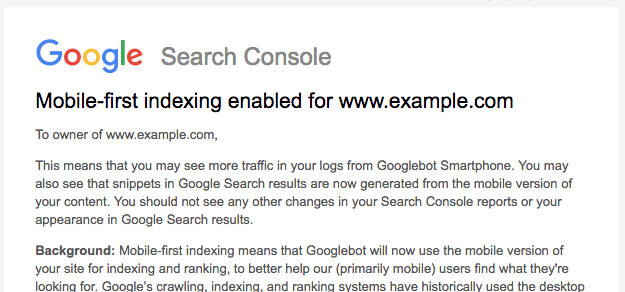What is Responsive Design
Responsive websites are designed to adapt to the size of screen which they're being viewed on. The term responsive web design was coined in 2010 by web designer Ethan Marcotte.
“Responsive web design offers us a way forward, finally allowing us to design for the ebb and flow of things.” -Ethan Marcotte
Responsive website design shows one website to all online visitors. It's designed to look good on any device size. Three important design elements of a responsive website include:
- Text that's readable without zooming in
- Adequate space around elements to be tapped
- No horizontal scrolling
Responsive Website Design is Good for SEO
According to BrightEdge, 57 percent of all US online traffic now comes from smartphones and tablets. With this shift to mobile search versus over desktop, more emphases is being placed on mobile-friendly websites by ranking them higher in the search results.
In addition to ranking higher in the search results, responsive website design has multiple other SEO benefits:
Creating Usable Experience
A responsive website moves elements on the page to ensure a good user experience no matter how they're being viewed. Often the user experience is different from one device to the next. It's important to make everything work together as content adapts to smaller or even larger devices. For example a blog post with a sidebar might look fine on a desktop but when the website adapts to fit on a mobile device, the sidebar items are shifted and pushed between paragraphs of content. This does not offer a good user experience. Consider how the pieces of you website will move and where they'll fit based on the device being used.
More Mobile Traffic
BrightEdge, also reports 79% of keywords rank differently on mobile than they do on desktop. Google gives preferences in the search ranking results to websites that are mobile-friendly. When used with other SEO factors, your website can rank higher in the search results.
Faster Web Page Loading
Responsive website often load faster than ones that are not responsive. Faster website lead to a better experience for your website visitors. In addition to a positive user experience, page loading speed is one of Google's SEO ranking factors. It's crucial to ensure your website loads as quickly as possible to deliver the best experience for your users and to gain favor with the search engines.
Lower Bounce Rate
When a website visitor lands on a page of your website and then immediately leaves, this is called a bounce. Bounce rates are directly related to the amount of time a visitors spends on your website.
Google views a high bounce rate as content irrelevant to to the users search query. Poor design is another factor that affects bounce rate. A high bounce rate will negatively affect your SEO ranking. View a website that isn't responsive on a mobile device is extremely frustrating and may cause visitors to leave. You want to deliver a good mobile-friendly design that delivers content that is organized to be easy to find and understand.
What is Mobile-First Indexing
In the past, Google's algorithms would index and rank websites based on the desktop version of the website. By the time Google's "Mobilegeddon" search algorithm was announced in April of 2015, most people were already using mobile devices to search the internet.
In response to this algorithm change, website developers shifted towards responsive website design and mobile-friendly websites. Often these websites would show different versions to users on mobile devices than what was shown to desktop users. With the rise of mobile search, Google saw the need to ensure relevant search results were shown to both mobile and desktop users.
Mobile-first indexing means Google predominantly uses the mobile version of the content for indexing and ranking.
What this means is that Googlebot will only crawl and index the mobile version of your website. This ensures the majority of users find content optimized for the screen they're using.
Google has also explained it will have only one index for search results. It will not have a mobile-first index that is separate from its main index.
When Did Mobile-First Indexing Begin
Google officially announced a shift towards mobile-first indexing in November of 2016.
In 2018, Google announced they'd begun migrating websites that followed Google's Best Practices to mobile first indexing. Google is notifying webmasters and site owners when their websites are migrated to the mobile-first indexing process. These notifications will be show as a message in the Google Search Console.
In early March of 2020, Google announced that more than 70% of websites had been migrated to mobile-first indexing. It gave September 2020 as the deadline for all websites to be switched over to mobile-first indexing.
With the Covid pandemic, Google decided to give webmasters, SEOs, and developers more time to prepare for the change to mobile-first indexing. They extended their deadline to to March of 2021.
What Can You Do to Get Prepared for Mobile-First Indexing
If your website has not been switched to mobile-first indexing, now is the time to get it ready for the switch. Here's a few things Google mentions to prepare for mobile-first indexing:
Content - Consider what content you display on the mobile version of your website and what content you block. Are you delivering content your users are searching for whether they're on their mobile devices or on their computers?
Meta Tags - The robot meta tags you use on your desktop version should be the same as those used for your mobile version. Using different robot meta tags may cause Google to miss links on your website when mobile-first indexing is enable.
Images - Follow image and video best practices for the mobile version of your website. Be sure your images are high quality and resized appropriately.
How Responsive Design and Mobile-First Indexing Benefits Your Business
Responsive website design is absolutely necessary for your business. It's not an option you choose when checking off a list of what to include in your website design or redesign. Since Mobilegeddon, mobile-friendly content has generally been ranked higher in the search engine results for searches performed on a mobile device. Ranking has not been affected for searches performed on a desktop.
There are multiple benefits for you business to invest in a responsive website:
One website for every device - Responsive websites deliver a mobile-friendly version of your website to every device. Creating a second website is unnecessary as responsive design ensures it will look good on multiple screen sizes.
Cost effectiveness - Responsive website design is more cost effective because only one website needs to be created instead of two. One website dynamically scales the elements on the website to fit the device your visitor is using.
Easier analytics reporting - It's important to know where your website traffic comes from and how users interact with your website. Managing multiple versions makes it complicated to track and analyze your website traffic data through multiple conversion paths, funnels, and redirects. With a responsive website, you're able to view your analytics in one report for multiple devices.
Increase mobile website traffic - More than half of all web traffic originates from mobile devices. If you want your target audience to visit your website, you can't forego using a responsive website design.
Conclusion
Preparing your site for mobile-first indexing before Google's March deadline will ensure you deliver the best experience to your website visitors on all devices.






Leave a Comment
You must be logged in to post a comment.